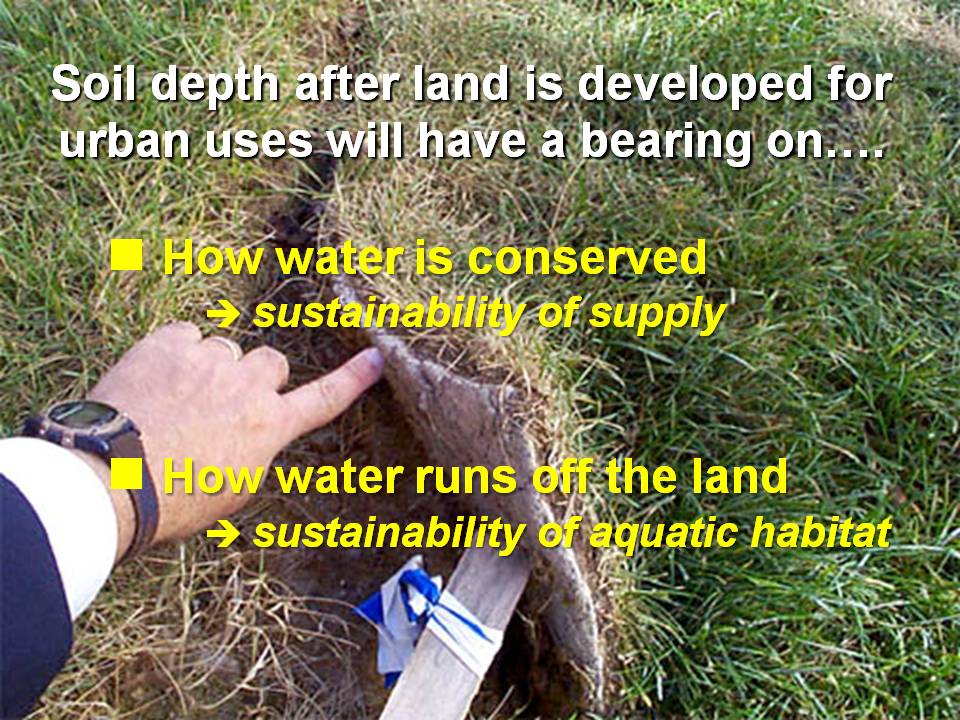Convening for Action in Maple Ridge: Understanding why RAINwater management is important
Note to Reader:
In April 2010, the District of Maple Ridge organized a “sharing and learning session” for its managers and senior technicians in engineering, operations and planning. Kim Stephens, Program Coordinator for the Water Sustainability Action Plan for British Columbia, was invited to help stimulate an inter-departmental conversation about implementing a new culture for watershed protection and/or restoration.
To download a copy of the set of PowerPoint slides that served as conversation starters, click on Beyond the Guidebook 2010: Implementing a New Culture for Urban Watershed Protection and Restoration in British Columbia. (1.4MB PDF)
Why Rainwater Management is Important
“The District is exploring how we will align our local actions with the provincial and regional policy framework for water sustainability in general, and rainwater management in particular,” states Rodney Stott, Environmental Planner.
 “There is an abundance of published information on Waterbucket. When everyone is so busy, however, it is a challenge to find time to take stock and absorb it all. We needed a way for all the departments to hear the same information at the same time; and we needed to know what is most relevant. The most efficient way to satisfy our information needs was to gather as a group and have a conversation with Kim Stephens.”
“There is an abundance of published information on Waterbucket. When everyone is so busy, however, it is a challenge to find time to take stock and absorb it all. We needed a way for all the departments to hear the same information at the same time; and we needed to know what is most relevant. The most efficient way to satisfy our information needs was to gather as a group and have a conversation with Kim Stephens.”
“Two questions framed the conversation: why is rainwater management important; and how are other BC communities implementing it?
Desired Outcomes: Create Liveable Communities & Protect Stream Health
“The key message is that a municipality’s desired outcomes drive rainwater management. This transcends the purely technical. Rainwater management is important because it is an essential element of community design. Desired outcomes are create liveable communities and protect stream health,” stated Kim Stephens at the Maple Ridge session.
 “The primary reason for planting street trees, for example, is to enhance the aesthetics which make a neighbourhood a nicer place in which to live. The rainwater management bonus is that the trees intercept rainfall that otherwise would become runoff and impact on stream stability.”
“The primary reason for planting street trees, for example, is to enhance the aesthetics which make a neighbourhood a nicer place in which to live. The rainwater management bonus is that the trees intercept rainfall that otherwise would become runoff and impact on stream stability.”
“Similarly, the stream values that a community wishes to protect are a driver for capturing rain where it falls and restoring it slowly via natural pathways. It requires an educational process so that everyone understands the connection, for example, between an absorbent landscape in backyards and stream health in a nearby watercourse amenity.”
Inter-Municipal Sharing
“I think that if there is one important thing I can take away from our workshop with Kim Stephens, it would be that our municipality can learn and borrow from the other successful case studies, municipal experiences, and resources that are readily available to us,” summarizes Rodney Stott.
“We are at an important cross roads where we are ready to make some minor amendments to our municipal tool kit that can lead to some significant improvements with respect to our current planning, engineering, operations, and building practices.”
From Stormwater Management to RAINwater Management
To help the Maple Ridge participants understand the distinction between Stormwater Management and RAINwater Management, Kim Stephens explained the three parts of the integrated strategy for managing the complete rainfall spectrum.
“Looking back, the traditional approach to drainage can be characterized as a ‘partial solution’. The reason for saying that is that we were effectively managing less than 10 of the 170 rainfall-days that we typically experience per year in the Metro Vancouver region.”
“It is only in the past decade that we have begun to implement ‘complete solutions’ by capturing rain where it falls.In this regard, there are two parts to the water sustainability equation: how water is conserved; and how water runs off the land. This is why we are placing so much emphasis on protecting and/or restoring the absorptive capacity of the urban landscape. The topsoil sponge is important.”
An Overview on Maple Ridge Contributions
“Starting in the early 1990s, the District of Maple Ridge has contributed to the advancement of rainwater management practices in British Columbia,” stated Kim Stephens. “The Cottonwood Stormwater Management Strategy was the template for the Stream Stewardship Guide. In its day, this was a significant accomplishment and an important building block.”
“In 2000, Mayor Al Hogarth was the catalyst who brought together Pitt Meadows and Abbotsford to co-host the last two events in the SmartStorm Forum Series. These were held in March 2001.”
“Also in 2001, the McKinney Creek watershed in Maple Ridge was a case study for development of the prototype Water Balance Model. This work is incorporated in Stormwater Planning: A Guidebook for British Columbia, released in 2002. The District also contributed the chapter on how to fund implementation of an integrated plan that achieves engineering, planning and environmental objectives.”
“In 2003, the District was a founding partner when the Inter-Governmental Partnership launched the web-based version of the Water Balance Model.”





